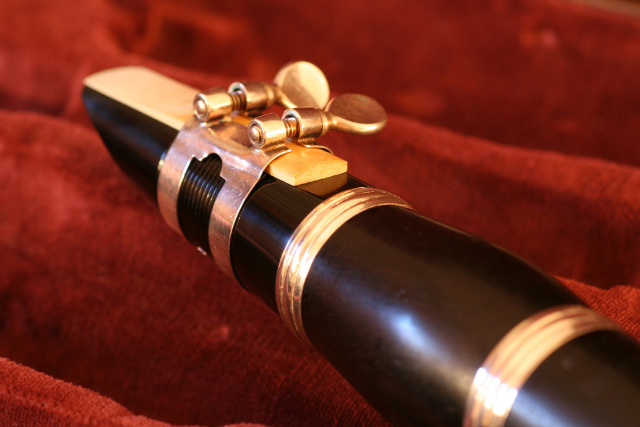Clarinetists want to produce a clear tone that has a bell-like quality to the sound. While clarinet players may aim for slightly different sounds from one another, most want to avoid sounding fuzzy or airy. That extra sound of air moving disrupts the beautiful tone quality of the clarinet.
There are many reasons for having a fuzzy or airy tone on the clarinet, but it’s generally possible to isolate the cause.
The most common problems that cause a fuzzy sound are due to the mouthpiece or the reed, incorrect embouchure or air support, low tongue position or a leak or crack in the clarinet.
Dealing with a fuzzy or airy sound can be frustrating, but it’s generally easy to resolve once you know what’s causing the problem.
See also:
How long does it take to play clarinet?
Is Playing Clarinet Bad For Your Teeth?
How Much Should I Practice Clarinet ?
Table of Contents
Mouthpiece issue causing a fuzzy sound

The first thing to consider if you’re producing a fuzzy sound throughout the range of the instrument is your mouthpiece.
There are many different clarinet mouthpieces to choose from, from the inexpensive stock mouthpieces often provided by the clarinet manufacturer, to the expensive hand-made brands used by many professionals.
Each mouthpiece is a little different in the way that it’s shaped. If your mouthpiece is very open, e.g. if the tip of the mouthpiece angles far from the tip of the reed, it can cause a fuzzy response.
A lighter reed can often help in this case, but it is also a good idea to try a mouthpiece that responds more easily.
Vandoren makes a variety of mouthpieces that are less open. The 5RV Lyre (Amazon, Guitar Center) is very popular. Other well-rated mouthpieces are the M13 Lyre and the M15.
See also: Vandoren vs Rico Reeds – Which to Choose?
It’s also a possibility that the mouthpiece may be damaged in some way. Check to see if the tip of the mouthpiece is cracked or chipped. If your sound is consistently fuzzy, this could be the culprit.
What if you have been playing on the same mouthpiece and reed strength for a while and only recently have started to have a fuzzy sound?
See also: When should I move up a reed size?
It could be that the mouthpiece has warped. You would probably need to find a repair person or mouthpiece maker in order to determine this.
If your mouthpiece is worth the effort, it may be possible to have this repaired, but most people just get a new mouthpiece.
Reed causing fuzzy or airy clarinet sound
The strength and quality of your reed can often lead to a fuzzy sound. If the strength is too hard (higher number) for you or the mouthpiece, it won’t vibrate with a clear sound. The low register will sound especially fuzzy.
Try using a lower strength reed and compare. Does the fuzziness disappear? Are the low notes responding as clearly as the upper notes?
Remember that a higher reed strength doesn’t determine your ability as a player. It’s a matter of finding the correct strength for you on the mouthpiece you’re using. A more open mouthpiece calls for a lighter reed, for example.
Finding quality reeds is a lifelong pursuit for most clarinetists. Not every reed will work well out of the box.
If you’re struggling with reeds, work with an instructor to learn the best techniques for breaking in and adjusting reeds. A reed that is warped or out of adjustment can make even the best clarinetist’s tone fuzzy.
This short video has helpful information on breaking reeds in and the importance of rotating the reeds you play on:
It’s also possible that the reed is damaged. A broken reed tip might cause you to produce a fuzzier sound. It’s usually best to discard a reed that’s broken.
Incorrect technique causing a fuzzy clarinet sound
Embouchure
An incorrect embouchure (how you use the muscles of your mouth to play a wind instrument) can cause a fuzzy tone.
Generally, if the embouchure is the problem, your tone will be airy throughout the range of the clarinet – perhaps clearing up as you play into the high register.
For a clarinet embouchure, you put your lower lip over your bottom teeth, your top teeth on the mouthpiece and close your lips to make a seal around the mouthpiece.
It’s very important that you make this seal firmly but without biting. Otherwise air will leak out, which can make your sound fuzzy.
Once your embouchure is correct, you must work to build the muscles needed for endurance. As the muscles used to form the embouchure get tired, it can be easy to start biting.
This changes how the reed is able to vibrate and can lead to air leaking and hence an airy tone.
Air Support for a clean clarinet tone
The strength and speed of the air going into the instrument is vital to good tone production. Weak or slow breath support can certainly produce a fuzzy sound because the reed isn’t vibrating consistently.
If you think this might be your problem, it’s a good idea to talk with your teacher about ways to improve your breath support. With some exercises directed at this issue, you can improve your tone quality significantly.
Tongue Position for a clear tone
This plays an important part in clarinet tone production as well. A higher tongue position increases the air speed which can help clear away fuzziness. Think of saying the syllable “ee” while playing. This puts your tongue in the correct position.
Although working on your embouchure, air support and tongue position may not be as exciting as learning to play higher and faster, they are elements to your playing that should always be developed from day one.
Only when these are in place can you sound like a skilled clarinetist when you play high and fast.
Clarinet mechanical issues
If your sound is airy, there may be a problem with your clarinet. If this if the case, the fuzzy sound will probably be localized around a specific area of the instrument.
For example, if the notes below Eb4 are fuzzy, one of your Eb keys may be leaking. It’s most likely the bottom side key on the right side of the upper joint.
Or it could also be the Eb/Bb sliver key between the second and third fingers of the left hand. The spring or the pad may need to be replaced.
To check for a leak like this, you need to air test the upper joint. Close all of the holes on the joint and then block air from coming out the bottom end with your right hand.
If you can hear the sound of air moving when you blow into the top of the joint, there is a leak.
If your sound is especially airy in a particular range of the instrument, there could also be a crack. Even a hairline crack can cause air to leak. A repair person is typically needed to fix that problem.
How to fix fuzzy/airy tone
| Cause | How to Fix It |
| Mouthpiece is too open | Use a mouthpiece like Vandoren 5RV Lyre, M13 Lyre or M15 |
| Mouthpiece is broken | It’s probably best to get a new clarinet mouthpiece |
| Mouthpiece is warped | Have a specialist work on the mouthpiece or buy a new one |
| Reed is too hard | Get lower strength reeds or learn to adjust reeds |
| Reed is not broken in | Learn the proper technique for breaking in clarinet reeds |
| Reed is broken | Use a different reed |
| Embouchure | Keep a firm seal with the lips without biting |
| Air support | Fill the instrument with fast air |
| Tongue position is too low | Keep the tongue high in the mouth. Think of saying the syllable “ee” |
| Instrument problem | Check for leaks. Check for cracks. Take the clarinet to a repair person |
Final words
Dealing with a fuzzy or airy sound on the clarinet can be frustrating because there are many possible causes. It’s important to do some detective work to identify what’s causing the fuzziness to the sound.
Some problems are for you to fix in your playing, like embouchure, air support and tongue position. You can also help by choosing the proper reed strength. Then it’s up to you to break in, adjust and rotate your reeds properly.
Other issues may require outside help. You may need to get a different mouthpiece that responds more easily. Or your clarinet may need to be repaired. It’s important to check for leaks and cracks.
Once you address these possible problems, you’ll find it’s possible to play with a full, clear tone that isn’t fuzzy or airy.

